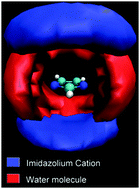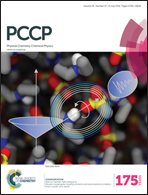Confined water in imidazolium based ionic liquids: a supramolecular guest@host complex case†
Abstract
It is well known that the macroscopic physico-chemical properties of ionic liquids (ILs) are influenced by the presence of water that strongly interferes with the supramolecular organization of these fluids. However, little is known about the function of water traces within this confined space and restricted ionic environments, i.e. between cations and anions. Using specially designed ILs namely 1,2,3-trimethyl-1H-imidazol-3-ium imidazol-1-ide (MMMI·Im) and 3-n-butyl-1,2-dimethyl-1H-imidazol-3-ium imidazol-1-ide (BMMI·Im), the structure and function of water have been determined in condensed, solution and gas phases by X-ray diffraction studies, NMR, molecular dynamics simulations (MDS) and DFT calculations. In the solid state the water molecule is trapped inside the ionic network (constituted of contact ion pairs formed by π+–π− interaction) through strong H-bonds involving the water hydrogens and the nitrogens of two imidazolate anions forming a guest@host supramolecular structure. A similar structural arrangement was corroborated by DFT calculations and MDS. The presence of a guest@host species (H2O@ILpair) is maintained to a great extent even in solution as detected by 1H–1H NOESY-experiments of the ILs dissolved in solvents with low and high dielectric constants. This confined water catalyses the H/D exchange with other substrates containing acidic-H such as chloroform.

- This article is part of the themed collection: SBQ-RSC: Celebrating UK-Brazil collaborations

 Please wait while we load your content...
Please wait while we load your content...